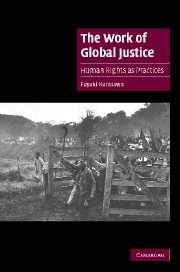Book contents
- Frontmatter
- Contents
- List of figures
- Preface
- Introduction: Theorizing the work of global justice
- 1 A message in a bottle: on bearing witness
- 2 The healing of wounds: on forgiveness
- 3 Cautionary tales: on foresight
- 4 The stranger's keeper: on aid
- 5 Cosmopolitanism from below: on solidarity
- Conclusion: Enacting a critical cosmopolitanism
- References
- Index
- Cambridge Cultural Social Studies
Preface
Published online by Cambridge University Press: 01 December 2009
- Frontmatter
- Contents
- List of figures
- Preface
- Introduction: Theorizing the work of global justice
- 1 A message in a bottle: on bearing witness
- 2 The healing of wounds: on forgiveness
- 3 Cautionary tales: on foresight
- 4 The stranger's keeper: on aid
- 5 Cosmopolitanism from below: on solidarity
- Conclusion: Enacting a critical cosmopolitanism
- References
- Index
- Cambridge Cultural Social Studies
Summary
This book, like many others I suppose, was born out of a false start of sorts. A few years ago, wrestling with the legacy of the twentieth century after reading Eric Hobsbawm's Age of Extremes and Paul Ricoeur's La mémoire, l'histoire, l'oubli, I began researching the aftermath of the atomic bomb blasts in Hiroshima and Nagasaki. While initially interested in what occurred in Japan itself, I rapidly became engrossed in the Faustian tale of some of the US-based physicists who had participated in the Manhattan Project out of which the atomic bomb was invented. Having come to realize the fearsome powers they had unleashed as well as the appropriation of the use of such powers by military and political leaders, brilliant and often mercurial figures such as J. Robert Oppenheimer, Hans Bethe and Leo Szilard felt a sense of responsibility, in differing ways and degrees, for what transpired on those fateful days in August 1945 and for the implications of the existence of atomic weapons for the future of humankind. Remorse was a common reaction, politicization was another – the latter leading to the establishment of what became known as the scientists' movement in the postwar United States and the founding of the Bulletin of the Atomic Scientists, among other initiatives. Although the following pages carry few traces of this initial project, I discovered the book's themes through it.
- Type
- Chapter
- Information
- The Work of Global JusticeHuman Rights as Practices, pp. xi - xviPublisher: Cambridge University PressPrint publication year: 2007

